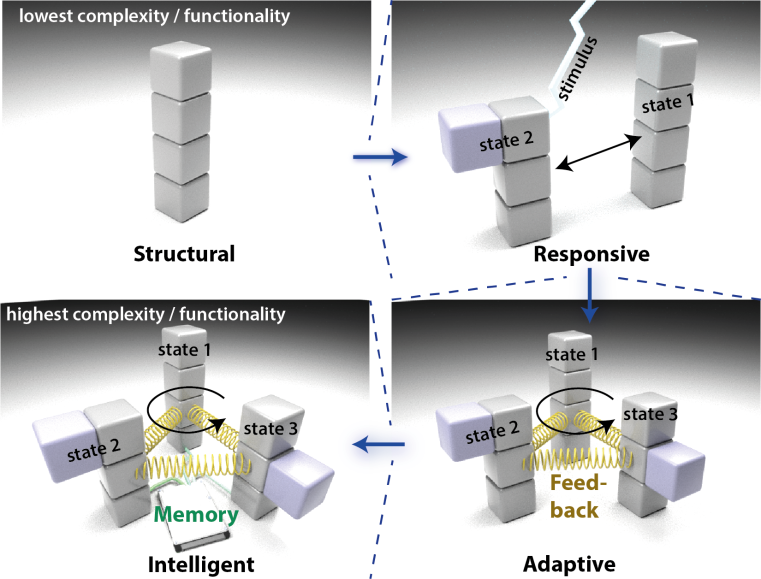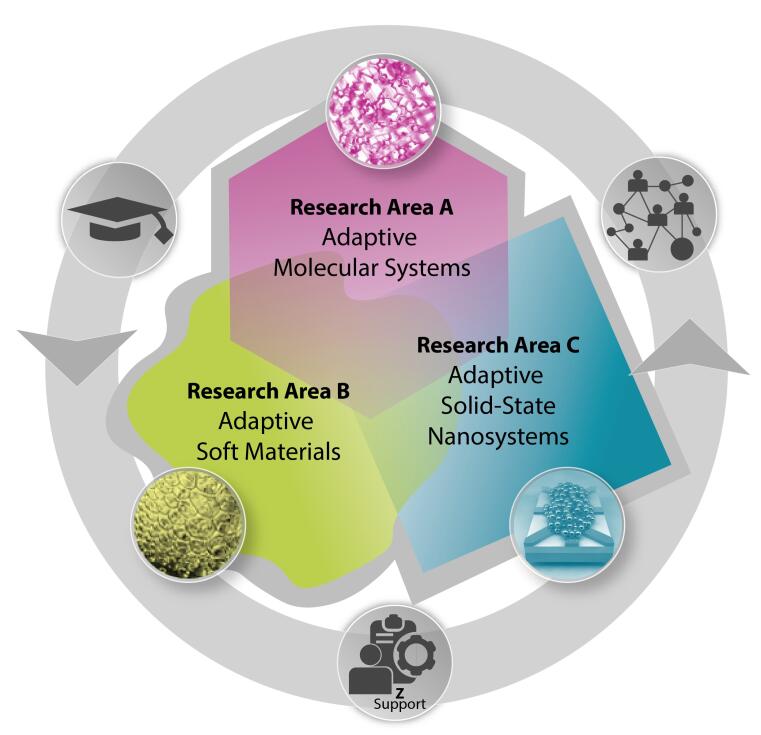Collaborative Research Centre 1459
Intelligent matter: From responsive to adaptive nanosystems
Intelligence is the ability to perceive information and to retain it as knowledge to be applied towards adaptive behaviour within a changing environment. This CRC is inspired by the question whether synthetic matter can provide artificial building blocks to enable intelligent abilities. Such intelligent matter would provide entirely new opportunities for instance for the development of artificial skin that self-regulates temperature and absorbance; soft robotics with adaptive tactility; and brain-inspired computing with reduced energy consumption. Intelligent matter likely requires an integrated system of materials and nanoscale components. Hence, the central scientific question of this CRC is: How does intelligent behaviour emerge in a system of nanoscale building blocks that operate collectively?

Intelligence is defined as the ability to perceive information and to retain it as knowledge to be applied towards adaptive behaviour in a changing environment. Although intelligence is often considered a capability that is unique to humans and animals, this CRC is inspired by the vision that synthetic matter could provide artificial building blocks to enable intelligent abilities. Such intelligent matter would open entirely new scientific opportunities with a wealth of potential technological applications such as the development of artificial skin, soft robotics, and brain-inspired computing. Since it is unlikely that the level of complexity required for intelligent behaviour can be realized in a single material, intelligent matter can probably only be achieved in an integrated system of materials and nanoscale components. Hence, the central scientific question of this CRC is: How does intelligent behaviour emerge in a system of nanoscale building blocks that operate collectively?
In the first funding period, we have focused on the progress from responsive matter to adaptive matter. Responsive matter contains embedded responsive building blocks that induce a change in properties upon exposure to an external stimulus, whereas adaptive matter has the additional capability to process feedback to regulate its properties. Ultimately, the CRC aims to develop intelligent matter which interacts with its environment, self-regulates its properties, and learns from the input it receives. Intelligent matter relies on the key functional elements of sensors, actuators, networks, and memory. In the first funding period, we have successfully implemented these key functional elements in three classes of adaptive matter (molecular systems, soft materials, and solid-state systems) demarcating the three research areas of the CRC.
In the second funding period, we aim to advance from adaptive matter to learning matter. By integrating memory into adaptive matter, we will introduce learning capability. Memory functionality is provided by feedback mechanisms based on molecular switches and reconfigurable nanostructures. We will implement a variety of learning concepts, ranging from conditioning to artificial neural networks and with applications ranging from reservoir computing to material learning. We will increasingly integrate multiple key elements of intelligent matter into a single nanosystem.
Our ambitious and interdisciplinary research programme is based on the concerted effort of a highly skilled team of project leaders from chemistry, physics, and related sciences. As a result of the synergy of experimental work with theoretical investigations and numerical simulations, the research programme converges toward the joint development of prototypes of artificial intelligent matter. Our pioneering research on intelligent matter enjoys worldwide recognition and further enhances the visibility of the nanosciences at the University of Münster.


